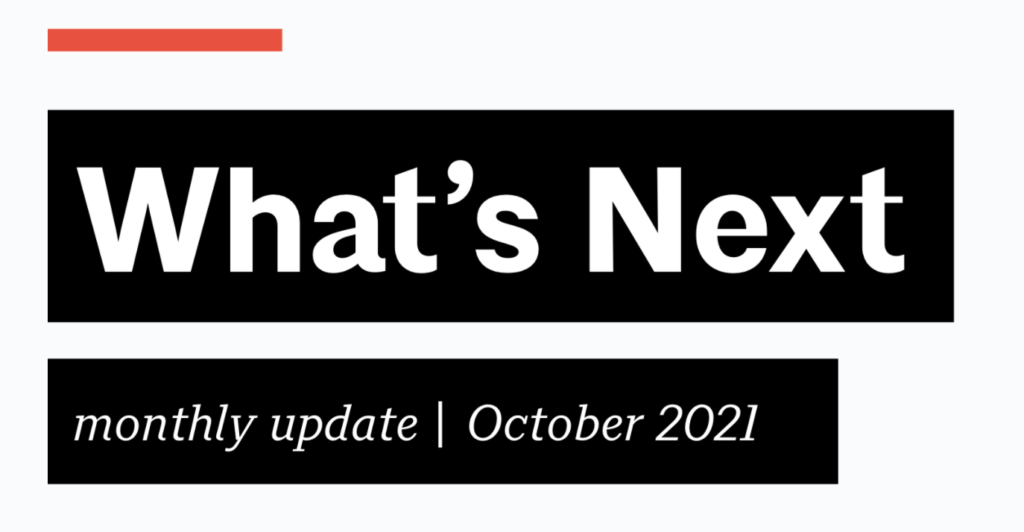What’s Next – AIA October Update

Architecture firms around the country are continuing to report strong billings growth even through the complications of the Delta variant. On the return-to-work front, short-term challenges remain—such as implementing and enforcing a business-wide vaccine policy—yet many firms are turning their attention back to developing long-term solutions to make our society healthier and more affordable.
Have feedback or content suggestions? We want to hear from you. Please contact us at feedback@aia.org.
State of Affairs
- 55.6: Despite nationwide concerns about the Delta variant, August’s Architecture Billings Score (ABI) indicated strong billings growth. Most firms are reporting robust business conditions, receiving many inquiries about new projects, and are seeing contract values grow for new design work.
- 197,400: The total number of employees in the architectural services sector.
- 12.2%: The office vacancy rate for Q2 reached its highest level since 2012.
Despite the rising office vacancy rate, Wells Fargo expects a wave of new office buildings to increase supply in the next few years—good news for architects. Additionally, they project office markets in the Sun Belt to outperform traditional gateway markets, bolstering prospects for that ever-growing region.
The Business of Practice
Despite the President’s vaccine order, businesses with fewer than 100 regular employees still have discretion on whether to require employee vaccination. The Harvard Business Review argues that they should—and also offers guidance on how to develop an ethical vaccine policy. Leaders, take note: New research shows that empathy not only strengthens relationships, it also drives significant business results . And it helps retain workers, which is critical since there are more jobs available and more workers quitting now than at any point in the last 20 years. (Check out the AIA Women’s Leadership Summit Virtual Series for guidance on how to grow your career in architecture.) Finally, legal experts believe the development of “smart construction” could streamline construction costs and management, possibly creating new opportunities for architects.
The Future of Design
If you subscribe to AIA’s Blueprint for Better newsletter, you’ve probably read about how a person’s neighborhood corresponds to their individual health outcomes. New research by Housing Policy Debate shows just how strong that connection is. In addition to these public health concerns, American cities also face a critical shortage of affordable housing. Fortunately, the Hack-A-House competition put our brightest young minds to work on this problem, encouraging them to come up with creative solutions during a 24-hour “hackathon” competition.
More creative energy flowed during the 2021 Chicago Architecture Biennial, which transformed vacant lots in the Windy City into stages for experimental design. Like many urban centers, Chicago looks and moves differently as a result of the COVID-19 pandemic—to learn more about how the disruption of migration patterns is impacting business, register for AIAU’s Virtual Migrations session.
Economic Outlook
While billings have continued to grow in the U.S., the Australian Institute of Architects has found similar trends happening down under—after a pandemic-induced slowdown, 55% of Australian respondents have retained and grown their client base over the last 12 months. Back in the States, Forbes caught up with AIA Chief Economist Kermit Baker to go over the highlights of our most recent Home Design Trends Survey, including the sharp uptick in demand for outdoor improvements, multiple home offices, and exercise spaces. You can join Kermit’s monthly webinar on October 21 for the latest on business conditions in the profession (registration required).
Our latest Work-on-the-Boards survey found that 65% of American firms have fully reopened their office and 18% have partially reopened. Of note: 38% of respondents said they would require vaccination for returning employees, even before President Biden announced that businesses with more than 100 employees would have to institute mandatory vaccination or testing protocols.
Legislative Analysis
Congress continues to negotiate an infrastructure package. There are two main infrastructure bills under consideration: The “Bipartisan Infrastructure Framework/ BIF” that the Senate passed in August (H.R. 3684) and a second bill to be passed through Budget Reconciliation. The House of Representatives suspended a vote on H.R. 3684 that had been planned for September 27 while Democrats continue to negotiate the size and scope of this second bill. Exact timing for action on both bills is unclear, but Congress extended some surface transportation programs to October 31, 2021. This establishes a new tentative deadline for Congress to act on H.R. 3684, or Congress will need to pass another extension of those surface transportation programs before they expire. AIA is continuing to advocate for investment in the building sector—notably schools, hospitals, affordable housing, and civic centers—to be included in both bills.
Meanwhile, Congress is expected to finalize a deal next week to raise the debt ceiling before the U.S. Treasury Department runs out of “extraordinary measures” to pay down U.S. receipts on October 18, 2021. The deal would raise the debt ceiling until early December. A default on the U.S. debt is unprecedented and Treasury Secretary Yellen warns that it could damage the economy and borrowing power of the federal government.
